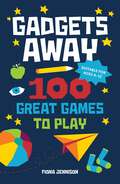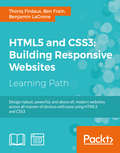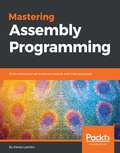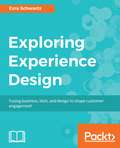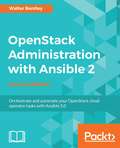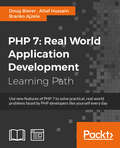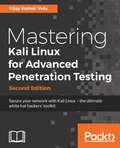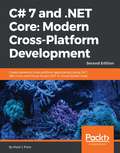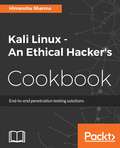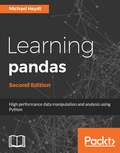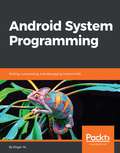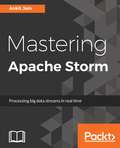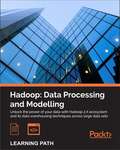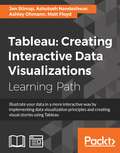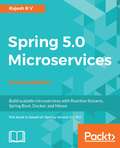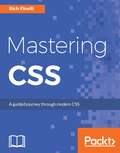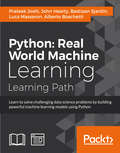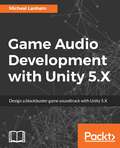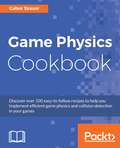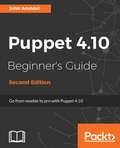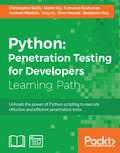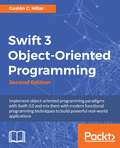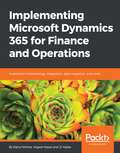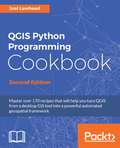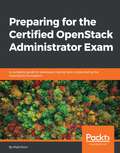- Table View
- List View
Gadgets Away: 100 Games To Play With The Family
by Fiona JennisonTechnology has become the too-easy way to entertain ourselves and our children. This easy-to-use, imaginative book has everything. There’s plenty of fun here to keep your family laughing: Sporty games and playground classics Activities for indoors, gardens, parks and beaches Memory and travel games, brain teasers and magic tricks
HTML5 and CSS3: Building Responsive Websites
by Thoriq Firdaus Ben Frain Benjamin LagroneDesign robust, powerful, and above all, modern websites across all manner of devices with ease using HTML5 and CSS3 About This Book * Use Responsive Grid System, Bootstrap, and Foundation frameworks for responsive web design * Learn how to use the latest features of CSS including custom fonts, nth-child selectors (and some CSS4 selectors), CSS custom properties (variables), and CSS calc * Make a mobile website using jQuery mobile and mobile-first design Who This Book Is For This course is for web developers who are familiar with HTML and CSS but want to understand the essentials of responsive web design. It is for those developers who are willing to seek innovative techniques that deliver fast, intuitive interfacing with the latest mobile Internet devices. What You Will Learn * Build a semantic website structure with HTML5 elements * Use Bower to organize website dependencies * Make responsive media that is optimized for the specific device on which it's displayed, allowing images, videos, and other elements be fully appreciated * Make typography that's fluidly responsive, so it's easy to read on all devices--no more hard-to-see text on a tiny mobile screen * Get to know techniques for server-side and client-side media deployment, providing platforms that are scaled for any device that requests them In Detail Responsive web design is an explosive area of growth in modern web development due to the huge volume of different device sizes and resolutions that are now commercially available. The Internet is going mobile. Desktop-only websites just aren't good enough anymore. With mobile internet usage still rising and tablets changing internet consumption habits, you need to know how to build websites that will just "work," regardless of the devices used to access them. This Learning Path course explains all the key approaches necessary to create and maintain a modern responsive design using HTML5 and CSS3. Our first module is a step-by-step introduction to ease you into the responsive world, where you will learn to build engaging websites. With coverage of Responsive Grid System, Bootstrap, and Foundation, you will discover three of the most robust frameworks in responsive web design. Next, you'll learn to create a cool blog page, a beautiful portfolio site, and a crisp professional business site and make them all totally responsive. Packed with examples and a thorough explanation of modern techniques and syntax, the second module provides a comprehensive resource for all things "responsive." You'll explore the most up-to-date techniques and tools needed to build great responsive designs, ensuring that your projects won't just be built "right" for today, but in the future too. The last and the final module is your guide to obtaining full access to next generation devices and browser technology. Create responsive applications that make snappy connections for mobile browsers and give your website the latest design and development advantages to reach mobile devices. At the end of this course, you will learn to get and use all the tools you need to build and test your responsive web project performance and take your website to the next level. This Learning Path combines some of the best that Packt has to offer in one complete, curated package. It includes content from the following Packt products: * Responsive Web Design by Example: Beginner's Guide - Second Edition by Thoriq Firdaus * Responsive Web Design with HTML5 and CSS3 - Second Edition by Ben Frain * HTML5 and CSS3 Responsive Web Design Cookbook by Benjamin LaGrone Style and approach This Learning Path course provides a simplistic and easy way to build powerful, engaging, responsive, and future proof websites across devices using HTML5 and CSS3 to meet the demands of the modern web user.
Mastering Assembly Programming
by Alexey LyashkoIncorporate the assembly language routines in your high level language applications About This Book • Understand the Assembly programming concepts and the benefits of examining the AL codes generated from high level languages • Learn to incorporate the assembly language routines in your high level language applications • Understand how a CPU works when programming in high level languages Who This Book Is For This book is for developers who would like to learn about Assembly language. Prior programming knowledge of C and C++ is assumed. What You Will Learn • Obtain deeper understanding of the underlying platform • Understand binary arithmetic and logic operations • Create elegant and efficient code in Assembly language • Understand how to link Assembly code to outer world • Obtain in-depth understanding of relevant internal mechanisms of Intel CPU • Write stable, efficient and elegant patches for running processes In Detail The Assembly language is the lowest level human readable programming language on any platform. Knowing the way things are on the Assembly level will help developers design their code in a much more elegant and efficient way. It may be produced by compiling source code from a high-level programming language (such as C/C++) but can also be written from scratch. Assembly code can be converted to machine code using an assembler. The first section of the book starts with setting up the development environment on Windows and Linux, mentioning most common toolchains. The reader is led through the basic structure of CPU and memory, and is presented the most important Assembly instructions through examples for both Windows and Linux, 32 and 64 bits. Then the reader would understand how high level languages are translated into Assembly and then compiled into object code. Finally we will cover patching existing code, either legacy code without sources or a running code in same or remote process. Style and approach This book takes a step-by-step, detailed approach to Comprehensively learning Assembly Programming.
Exploring Experience Design
by Ezra SchwartzLearn how to unify Customer Experience, User Experience and more to shape lasting customer engagement in a world of rapid change. About This Book • An introductory guide to Experience Design that will help you break into XD as a career by gaining A strong foundational knowledge • Get acquainted with the various phases of a typical Experience Design workflow • Work through the key process and techniques in XD, supported by most of the common use cases Who This Book Is For This book is for designers who wish to enter the field of UX Design, especially Programmers, Content Strategists, and Organizations keen to understand the core concepts of UX Design. What You Will Learn • Understand why Experience Design (XD) is at the forefront of business priorities, as organizations race to innovate products and services in order to compete for customers in a global economy driven by technology and change • Get motivated by the numerous professional opportunities that XD opens up for practitioners in wide-ranging domains, and by the stories of real XD practitioners • Understand what experience is, how experiences are designed, and why they are effective • Gain knowledge of user-centered design principles, methodologies, and best practices that will improve your product (digital or physical) • Get to know your X's and D's—understand the differences between XD and UX, CX, IxD, IA, SD, VD, PD, and other design practices In Detail We live in an experience economy in which interaction with products is valued more than owning them. Products are expected to engage and delight in order to form the emotional bonds that forge long-term customer loyalty: Products need to anticipate our needs and perform tasks for us: refrigerators order food, homes monitor energy, and cars drive autonomously; they track our vitals, sleep, location, finances, interactions, and content use; recognize our biometric signatures, chat with us, understand and motivate us. Beautiful and easy to use, products have to be fully customizable to match our personal preferences. Accomplishing these feats is easier said than done, but a solution has emerged in the form of Experience design (XD), the unifying approach to fusing business, technology and design around a user-centered philosophy. This book explores key dimensions of XD: Close collaboration among interdisciplinary teams, rapid iteration and ongoing user validation. We cover the processes, methodologies, tools, techniques and best-practices practitioners use throughout the entire product development life-cycle, as ideas are transformed to into positive experiences which lead to perpetual customer engagement and brand loyalty. Style and approach An easy-to-understand guide, filled with real-world use cases on process, design, and techniques, helping you build a strong foundation in Experience Design.
OpenStack Administration with Ansible 2 - Second Edition
by Walter BentleyOrchestrate and automate your OpenStack cloud operator tasks with Ansible 2.0 About This Book • Automate real-world OpenStack cloud operator administrative tasks • Construct a collection of the latest automation code to save time on managing your OpenStack cloud • Manage containers on your cloud and check the health of your cloud using Nagios Who This Book Is For This book is aimed at OpenStack-based cloud operators and infrastructure and sys administrators who have some knowledge of OpenStack and are seeking to automate taxing and manual tasks. This book is also for people new to automating cloud operations in general and the DevOps practice in particular. What You Will Learn • Efficiently execute OpenStack administrative tasks • Familiarize yourself with how Ansible 2 works and assess the defined best practices • Create Ansible 2 playbooks and roles • Automate tasks to customize your OpenStack cloud • Review OpenStack automation considerations when automating administrative tasks • Examine and automate advanced OpenStack tasks and designated use cases • Get a high-level overview of OpenStack and current production-ready projects • Explore OpenStack CLI tools and learn how to use them In Detail Most organizations are seeking methods to improve business agility because they have realized just having a cloud is not enough. Being able to improve application deployments, reduce infrastructure downtime, and eliminate daily manual tasks can only be accomplished through some sort of automation. We start with a brief overview of OpenStack and Ansible 2 and highlight some best practices. Each chapter will provide an introduction to handling various Cloud Operator administration tasks such as managing containers within your cloud; setting up/utilizing open source packages for monitoring; creating multiple users/tenants; taking instance snapshots; and customizing your cloud to run multiple active regions. Each chapter will also supply a step-by-step tutorial on how to automate these tasks with Ansible 2. Packed with real-world OpenStack administrative tasks, this book will walk you through working examples and explain how these tasks can be automated using one of the most popular open source automation tools on the market today. Style and approach This book is a concise, fast-paced guide filled with real-world scenarios that will execute OpenStack administrative tasks efficiently. It serves as a quick reference guide for not just OpenStack functions, but also for creating future Ansible code.
PHP 7: Real World Application Development
by Altaf Hussain Doug Bierer Branko AjzeleUse new features of PHP 7 to solve practical, real-world problems faced by PHP developers like yourself every day. About This Book * This course covers the new features of version 7.x, best practices for server-side programming, and MVC frameworks * Leverage the potential of PHP for server-side programming, memory management, and Object-Oriented Programming to improve your programming productivity * This course also illustrates the development of a complete modular application using PHP 7 in detail Who This Book Is For If you are an aspiring web developer, mobile developer, or back-end programmer, who has basic experience in PHP programming and wants to develop performance-critical applications, then this course is for you. It will take your PHP programming skills to next level. What You Will Learn * Solve practical real-world programming problems using PHP 7 * Discover where and when PHP 5 code needs to be re-written to avoid backwards-compatibility breaks * Use advanced PHP 7 features such as the Abstract Syntax Tree, Uniform Variable Syntax, Scalar Type Hints, Generator Delegation, Anonymous Classes, and the Context Sensitive Lexer * Set up a high performance development and production environment for PHP 7 * Discover new OOP features in PHP 7 to achieve high performance * Discover the new features of PHP 7 that are relevant to modular application development * Explore the ins and outs of the Symfony framework * Build a set of modules based on the Symfony framework that comprise a simple web shop app In Detail PHP is a great language for developing web applications. It is essentially a server-side scripting language. PHP 7 is the latest version, providing major backward-compatibility breaks and focusing on improved performance and speed. This course follows a learning path which is divided into three modules. Each module is a mini course in its own right, taking your basic PHP programing skills to the next level by showing you intermediate to advanced PHP techniques with a focus on PHP 7. This way, get you equipped with the tools and skills required to develop professional and efficient applications for your websites and enterprises. The first module of the book is a programming cookbook that consists over 80 recipes! Each recipe is designed to solve practical, real-world problems faced by PHP developers like yourself every day. This course also covers new ways of writing PHP code made possible only in version 7. The second module of the course is designed to improve the performance and productivity of your application. We'll introduce you to the concepts of Object-Oriented Programming (OOP) in PHP 7, then shed some light on how to improve the performance of your PHP 7 applications and database. Throughout this module you will be introduced to benchmarking tools. With all important concepts of PHP covered up you will move on to third module. In this module you will gain a deep insight into the modular programming paradigm and how to achieve modularity in your PHP code. Modular design techniques help you build readable, manageable, reusable, and more efficient codes. PHP 7, which is a popular open source scripting language, is used to build modular functions for your software. This Learning Path combines some of the best that Packt has to offer in one complete, curated package. It includes content from the following Packt products: * PHP 7 Programming Cookbook, Doug Bierer * Learning PHP 7 High Performance, Altaf Hussain * Modular Programming with PHP 7, Branko Ajzele Style and approach This book takes a practical, step-by-step approach with real-world examples that serve as building blocks for your application development and guide you through improving the quality of your code.
Mastering Kali Linux for Advanced Penetration Testing, Second Edition
by Vijay Kumar VeluMastering Kali Linux for Advanced Penetration Testing will provide you with a number or proven techniques to defeat the latest defences on the networks using Kali Linux. From selecting the most effective tools, to rapidly compromising network security, to highlighting the techniques used to avoid detection.
C# 7 and .NET Core: Modern Cross-Platform Development - Second Edition
by Mark J. PriceModern Cross-Platform Development About This Book • Build modern, cross-platform applications with .NET Core • Get up to speed with C#, and up to date with all the latest features of C# 7 • Start creating professional web applications with ASP.NET Core Who This Book Is For This book is targeted towards readers who have some prior programming experience or have a science, technology, engineering, or mathematics (STEM) background, and want to gain a solid foundation with C# and to be introduced to the types of applications they could build and will work cross-platform on Windows, Linux, and macOS. What You Will Learn • Build cross-platform applications using C# 7 and .NET Core • Explore ASP.NET Core and learn how to create professional web applications • Improve your application's performance using multitasking • Use Entity Framework Core and find out how to build code-first databases • Master object-oriented programming with C# to increase code reuse and efficiency • Familiarize yourself with cross-device app development using the Universal Windows Platform and XAML • Query and manipulate data using LINQ • Protect your data by using encryption and hashing In Detail If you want to build powerful cross-platform applications with C# 7 and .NET Core, then this book is for you. First, we'll run you through the basics of C#, as well as object-oriented programming, before taking a quick tour through the latest features of C# 7 such as tuples, pattern matching, out variables, and so on. After quickly taking you through C# and how .NET works, we'll dive into the .NET Standard 1.6 class libraries, covering topics such as performance, monitoring, debugging, serialization and encryption. The final section will demonstrate the major types of application that you can build and deploy cross-device and cross-platform. In this section, we'll cover Universal Windows Platform (UWP) apps, web applications, mobile apps, and web services. Lastly, we'll look at how you can package and deploy your applications so that they can be hosted on all of today's most popular platforms, including Linux and Docker. By the end of the book, you'll be armed with all the knowledge you need to build modern, cross-platform applications using C# and .NET Core. Style and approach This book takes a step-by-step approach and is filled with exciting projects and fascinating theory. It uses three high-impact sections to equip you with all the tools you'll need to build modern, cross-platform applications using C# and .NET Core.
Kali Linux - An Ethical Hacker's Cookbook
by Himanshu SharmaOver 120 recipes to perform advanced penetration testing with Kali Linux About This Book • Practical recipes to conduct effective penetration testing using the powerful Kali Linux • Leverage tools like Metasploit, Wireshark, Nmap, and many more to detect vulnerabilities with ease • Confidently perform networking and application attacks using task-oriented recipes Who This Book Is For This book is aimed at IT security professionals, pentesters, and security analysts who have basic knowledge of Kali Linux and want to conduct advanced penetration testing techniques. What You Will Learn • Installing, setting up and customizing Kali for pentesting on multiple platforms • Pentesting routers and embedded devices • Bug hunting 2017 • Pwning and escalating through corporate network • Buffer over?ows 101 • Auditing wireless networks • Fiddling around with software-defned radio • Hacking on the run with NetHunter • Writing good quality reports In Detail With the current rate of hacking, it is very important to pentest your environment in order to ensure advanced-level security. This book is packed with practical recipes that will quickly get you started with Kali Linux (version 2016.2) according to your needs, and move on to core functionalities. This book will start with the installation and configuration of Kali Linux so that you can perform your tests. You will learn how to plan attack strategies and perform web application exploitation using tools such as Burp, and Jexboss. You will also learn how to perform network exploitation using Metasploit, Sparta, and Wireshark. Next, you will perform wireless and password attacks using tools such as Patator, John the Ripper, and airoscript-ng. Lastly, you will learn how to create an optimum quality pentest report! By the end of this book, you will know how to conduct advanced penetration testing thanks to the book's crisp and task-oriented recipes. Style and approach This is a recipe-based book that allows you to venture into some of the most cutting-edge practices and techniques to perform penetration testing with Kali Linux.
Learning pandas - Second Edition
by Michael HeydtGet to grips with pandas—a versatile and high-performance Python library for data manipulation, analysis, and discovery About This Book • Get comfortable using pandas and Python as an effective data exploration and analysis tool • Explore pandas through a framework of data analysis, with an explanation of how pandas is well suited for the various stages in a data analysis process • A comprehensive guide to pandas with many of clear and practical examples to help you get up and using pandas Who This Book Is For This book is ideal for data scientists, data analysts, Python programmers who want to plunge into data analysis using pandas, and anyone with a curiosity about analyzing data. Some knowledge of statistics and programming will be helpful to get the most out of this book but not strictly required. Prior exposure to pandas is also not required. What You Will Learn • Understand how data analysts and scientists think about of the processes of gathering and understanding data • Learn how pandas can be used to support the end-to-end process of data analysis • Use pandas Series and DataFrame objects to represent single and multivariate data • Slicing and dicing data with pandas, as well as combining, grouping, and aggregating data from multiple sources • How to access data from external sources such as files, databases, and web services • Represent and manipulate time-series data and the many of the intricacies involved with this type of data • How to visualize statistical information • How to use pandas to solve several common data representation and analysis problems within finance In Detail You will learn how to use pandas to perform data analysis in Python. You will start with an overview of data analysis and iteratively progress from modeling data, to accessing data from remote sources, performing numeric and statistical analysis, through indexing and performing aggregate analysis, and finally to visualizing statistical data and applying pandas to finance. With the knowledge you gain from this book, you will quickly learn pandas and how it can empower you in the exciting world of data manipulation, analysis and science. Style and approach • Step-by-step instruction on using pandas within an end-to-end framework of performing data analysis • Practical demonstration of using Python and pandas using interactive and incremental examples
Android System Programming
by Roger YeBuild, customize, and debug your own Android system About This Book • Master Android system-level programming by integrating, customizing, and extending popular open source projects • Use Android emulators to explore the true potential of your hardware • Master key debugging techniques to create a hassle-free development environment Who This Book Is For This book is for Android system programmers and developers who want to use Android and create indigenous projects with it. You should know the important points about the operating system and the C/C++ programming language. What You Will Learn • Set up the Android development environment and organize source code repositories • Get acquainted with the Android system architecture • Build the Android emulator from the AOSP source tree • Find out how to enable WiFi in the Android emulator • Debug the boot up process using a customized Ramdisk • Port your Android system to a new platform using VirtualBox • Find out what recovery is and see how to enable it in the AOSP build • Prepare and test OTA packages In Detail Android system programming involves both hardware and software knowledge to work on system level programming. The developers need to use various techniques to debug the different components in the target devices. With all the challenges, you usually have a deep learning curve to master relevant knowledge in this area. This book will not only give you the key knowledge you need to understand Android system programming, but will also prepare you as you get hands-on with projects and gain debugging skills that you can use in your future projects. You will start by exploring the basic setup of AOSP, and building and testing an emulator image. In the first project, you will learn how to customize and extend the Android emulator. Then you'll move on to the real challenge—building your own Android system on VirtualBox. You'll see how to debug the init process, resolve the bootloader issue, and enable various hardware interfaces. When you have a complete system, you will learn how to patch and upgrade it through recovery. Throughout the book, you will get to know useful tips on how to integrate and reuse existing open source projects such as LineageOS (CyanogenMod), Android-x86, Xposed, and GApps in your own system. Style and approach This is an easy-to-follow guide full of hands-on examples and system-level programming tips.
Mastering Apache Storm
by Ankit JainMaster the intricacies of Apache Storm and develop real-time stream processing applications with ease About This Book • Exploit the various real-time processing functionalities offered by Apache Storm such as parallelism, data partitioning, and more • Integrate Storm with other Big Data technologies like Hadoop, HBase, and Apache Kafka • An easy-to-understand guide to effortlessly create distributed applications with Storm Who This Book Is For If you are a Java developer who wants to enter into the world of real-time stream processing applications using Apache Storm, then this book is for you. No previous experience in Storm is required as this book starts from the basics. After finishing this book, you will be able to develop not-so-complex Storm applications. What You Will Learn • Understand the core concepts of Apache Storm and real-time processing • Follow the steps to deploy multiple nodes of Storm Cluster • Create Trident topologies to support various message-processing semantics • Make your cluster sharing effective using Storm scheduling • Integrate Apache Storm with other Big Data technologies such as Hadoop, HBase, Kafka, and more • Monitor the health of your Storm cluster In Detail Apache Storm is a real-time Big Data processing framework that processes large amounts of data reliably, guaranteeing that every message will be processed. Storm allows you to scale your data as it grows, making it an excellent platform to solve your big data problems. This extensive guide will help you understand right from the basics to the advanced topics of Storm. The book begins with a detailed introduction to real-time processing and where Storm fits in to solve these problems. You'll get an understanding of deploying Storm on clusters by writing a basic Storm Hello World example. Next we'll introduce you to Trident and you'll get a clear understanding of how you can develop and deploy a trident topology. We cover topics such as monitoring, Storm Parallelism, scheduler and log processing, in a very easy to understand manner. You will also learn how to integrate Storm with other well-known Big Data technologies such as HBase, Redis, Kafka, and Hadoop to realize the full potential of Storm. With real-world examples and clear explanations, this book will ensure you will have a thorough mastery of Apache Storm. You will be able to use this knowledge to develop efficient, distributed real-time applications to cater to your business needs. Style and approach This easy-to-follow guide is full of examples and real-world applications to help you get an in-depth understanding of Apache Storm. This book covers the basics thoroughly and also delves into the intermediate and slightly advanced concepts of application development with Apache Storm.
Hadoop: Data Processing and Modelling
by Sandeep Karanth Garry Turkington Tanmay DeshpandeUnlock the power of your data with Hadoop 2.X ecosystem and its data warehousing techniques across large data sets About This Book * Conquer the mountain of data using Hadoop 2.X tools * The authors succeed in creating a context for Hadoop and its ecosystem * Hands-on examples and recipes giving the bigger picture and helping you to master Hadoop 2.X data processing platforms * Overcome the challenging data processing problems using this exhaustive course with Hadoop 2.X Who This Book Is For This course is for Java developers, who know scripting, wanting a career shift to Hadoop - Big Data segment of the IT industry. So if you are a novice in Hadoop or an expert, this book will make you reach the most advanced level in Hadoop 2.X. What You Will Learn * Best practices for setup and configuration of Hadoop clusters, tailoring the system to the problem at hand * Integration with relational databases, using Hive for SQL queries and Sqoop for data transfer * Installing and maintaining Hadoop 2.X cluster and its ecosystem * Advanced Data Analysis using the Hive, Pig, and Map Reduce programs * Machine learning principles with libraries such as Mahout and Batch and Stream data processing using Apache Spark * Understand the changes involved in the process in the move from Hadoop 1.0 to Hadoop 2.0 * Dive into YARN and Storm and use YARN to integrate Storm with Hadoop * Deploy Hadoop on Amazon Elastic MapReduce and Discover HDFS replacements and learn about HDFS Federation In Detail As Marc Andreessen has said "Data is eating the world," which can be witnessed today being the age of Big Data, businesses are producing data in huge volumes every day and this rise in tide of data need to be organized and analyzed in a more secured way. With proper and effective use of Hadoop, you can build new-improved models, and based on that you will be able to make the right decisions. The first module, Hadoop beginners Guide will walk you through on understanding Hadoop with very detailed instructions and how to go about using it. Commands are explained using sections called "What just happened" for more clarity and understanding. The second module, Hadoop Real World Solutions Cookbook, 2nd edition, is an essential tutorial to effectively implement a big data warehouse in your business, where you get detailed practices on the latest technologies such as YARN and Spark. Big data has become a key basis of competition and the new waves of productivity growth. Hence, once you get familiar with the basics and implement the end-to-end big data use cases, you will start exploring the third module, Mastering Hadoop. So, now the question is if you need to broaden your Hadoop skill set to the next level after you nail the basics and the advance concepts, then this course is indispensable. When you finish this course, you will be able to tackle the real-world scenarios and become a big data expert using the tools and the knowledge based on the various step-by-step tutorials and recipes. Style and approach This course has covered everything right from the basic concepts of Hadoop till you master the advance mechanisms to become a big data expert. The goal here is to help you learn the basic essentials using the step-by-step tutorials and from there moving toward the recipes with various real-world solutions for you. It covers all the important aspects of Hadoop from system designing and configuring Hadoop, machine learning principles with various libraries with chapters illustrated with code fragments and schematic diagrams. This is a compendious course to explore Hadoop from the basics to the most advanced techniques available in Hadoop 2.X.
Tableau: Creating Interactive Data Visualizations
by Matt Floyd Jen Stirrup Ashutosh Nandeshwar Ashley OhmannIllustrate your data in a more interactive way by implementing data visualization principles and creating visual stories using Tableau About This Book * Use data visualization principles to help you to design dashboards that enlighten and support business decisions * Integrate your data to provide mashed-up dashboards * Connect to various data sources and understand what data is appropriate for Tableau Public * Understand chart types and when to use specific chart types with different types of data Who This Book Is For Data scientists who have just started using Tableau and want to build on the skills using practical examples. Familiarity with previous versions of Tableau will be helpful, but not necessary. What You Will Learn * Customize your designs to meet the needs of your business using Tableau * Use Tableau to prototype, develop, and deploy the final dashboard * Create filled maps and use any shape file * Discover features of Tableau Public, from basic to advanced * Build geographic maps to bring context to data * Create filters and actions to allow greater interactivity to Tableau Public visualizations and dashboards * Publish and embed Tableau visualizations and dashboards in articles In Detail With increasing interest for data visualization in the media, businesses are looking to create effective dashboards that engage as well as communicate the truth of data. Tableau makes data accessible to everyone, and is a great way of sharing enterprise dashboards across the business. Tableau is a revolutionary toolkit that lets you simply and effectively create high-quality data visualizations. This course starts with making you familiar with its features and enable you to develop and enhance your dashboard skills, starting with an overview of what dashboard is, followed by how you can collect data using various mathematical formulas. Next, you'll learn to filter and group data, as well as how to use various functions to present the data in an appealing and accurate way. In the first module, you will learn how to use the key advanced string functions to play with data and images. You will be walked through the various features of Tableau including dual axes, scatterplot matrices, heat maps, and sizing.In the second module, you'll start with getting your data into Tableau, move onto generating progressively complex graphics, and end with the finishing touches and packaging your work for distribution. This module is filled with practical examples to help you create filled maps, use custom markers, add slider selectors, and create dashboards. You will learn how to manipulate data in various ways by applying various filters, logic, and calculating various aggregate measures. Finally, in the third module, you learn about Tableau Public using which allows readers to explore data associations in multiple-sourced public data, and uses state-of-the-art dashboard and chart graphics to immerse the users in an interactive experience. In this module, the readers can quickly gain confidence in understanding and expanding their visualization, creation knowledge, and quickly create interesting, interactive data visualizations to bring a richness and vibrancy to complex articles. The course provides a great overview for beginner to intermediate Tableau users, and covers the creation of data visualizations of varying complexities. Style and approach The approach will be a combined perspective, wherein we start by performing some basic recipes and move on to some advanced ones. Finally, we perform some advanced analytics and create appealing and insightful data stories using Tableau Public in a step-by-step manner.
Spring 5.0 Microservices - Second Edition
by Rajesh R VA practical, comprehensive, and user-friendly approach to building microservices in Spring About This Book • Update existing applications to integrate reactive streams released as a part of Spring 5.0 • Learn how to use Docker and Mesos to push the boundaries and build successful microservices • Upgrade the capability model to implement scalable microservices Who This Book Is For This book is ideal for Spring developers who want to build cloud-ready, Internet-scale applications, and simple RESTful services to meet modern business demands. What You Will Learn • Familiarize yourself with the microservices architecture and its benefits • Find out how to avoid common challenges and pitfalls while developing microservices • Use Spring Boot and Spring Cloud to develop microservices • Handle logging and monitoring microservices • Leverage Reactive Programming in Spring 5.0 to build modern cloud native applications • Manage internet-scale microservices using Docker, Mesos, and Marathon • Gain insights into the latest inclusion of Reactive Streams in Spring and make applications more resilient and scalable In Detail The Spring Framework is an application framework and inversion of the control container for the Java platform. The framework's core features can be used by any Java application, but there are extensions to build web applications on top of the Java EE platform. This book will help you implement the microservice architecture in Spring Framework, Spring Boot, and Spring Cloud. Written to the latest specifications of Spring that focuses on Reactive Programming, you'll be able to build modern, internet-scale Java applications in no time. The book starts off with guidelines to implement responsive microservices at scale. Next, you will understand how Spring Boot is used to deploy serverless autonomous services by removing the need to have a heavyweight application server. Later, you'll learn how to go further by deploying your microservices to Docker and managing them with Mesos. By the end of the book, you will have gained more clarity on the implementation of microservices using Spring Framework and will be able to use them in internet-scale deployments through real-world examples. Style and approach The book takes a step-by-step approach on developing microservices using Spring Framework, Spring Boot, and a set of Spring Cloud components that will help you scale your applications.
Mastering CSS
by Rich FinelliRich Finelli's modern CSS training course, based on his bestselling Mastering CSS video, now available in a book. Master CSS from best practices to practical CSS coding. About This Book • Learn CSS directly from Rich Finelli, author of the bestselling Mastering CSS training course • From best practices to deep coding, Rich Finelli shares his CSS knowledge with you • Rich Finelli covers the latest CSS updates with flexbox and works with retina devices Who This Book Is For This book is for web designers who wish to master the best practices of CSS in their web projects. You already know how to work with a web page, and want to use CSS to master website presentation. What You Will Learn • Master fundamental CSS concepts like the anatomy of a rule set, the box model, and the differences between block and inline elements • Employ flexbox to layout and align elements simply and cleanly • Become proficient with CSS3 properties such as transitions, transforms, gradients, and animations • Delve into modular, reusable, and scalable CSS for more organized and maintainable style sheets • Understand media queries and other pillars of responsive web design • Get creative with the @font-face property, Google Web Fonts, font services such as Typekit, as well as, icon fonts • Understand the workflow for HiDPI (retina) devices using 2x images, SVG, and the srcset attribute In Detail Rich Finelli trains you in CSS deep learning and shows you the techniques you need to work in the world of responsive, feature-rich web applications. Based on his bestselling Mastering CSS training video, you can now learn with Rich in this book! Rich shares with you his skills in creating advanced layouts, and the critical CSS insights you need for responsive web designs, fonts, transitions, animations, and using flexbox. Rich begins your CSS training with a review of CSS best practices, such as using a good text editor to automate your authoring and setting up a CSS baseline. You then move on to create a responsive layout making use of floats and stylable drop-down menus, with Rich guiding you toward a modular-organized approach to CSS. Your training with Rich Finelli then dives into detail about working with CSS and the best solutions to make your websites work. You'll go with him into CSS3 properties, transforms, transitions, and animations. You'll gain his understanding of responsive web designs, web fonts, icon fonts, and the techniques used to support retina devices. Rich expands your knowledge of CSS so you can master one of the most valuable tools in modern web design. Style and approach Let Rich Finelli train you in CSS! This book has a direct training style because it is based on Rich's bestselling Mastering CSS training course.
Python: Real World Machine Learning
by Prateek Joshi Luca Massaron John Hearty Bastiaan Sjardin Alberto BoschettiLearn to solve challenging data science problems by building powerful machine learning models using Python About This Book * Understand which algorithms to use in a given context with the help of this exciting recipe-based guide * This practical tutorial tackles real-world computing problems through a rigorous and effective approach * Build state-of-the-art models and develop personalized recommendations to perform machine learning at scale Who This Book Is For This Learning Path is for Python programmers who are looking to use machine learning algorithms to create real-world applications. It is ideal for Python professionals who want to work with large and complex datasets and Python developers and analysts or data scientists who are looking to add to their existing skills by accessing some of the most powerful recent trends in data science. Experience with Python, Jupyter Notebooks, and command-line execution together with a good level of mathematical knowledge to understand the concepts is expected. Machine learning basic knowledge is also expected. What You Will Learn * Use predictive modeling and apply it to real-world problems * Understand how to perform market segmentation using unsupervised learning * Apply your new-found skills to solve real problems, through clearly-explained code for every technique and test * Compete with top data scientists by gaining a practical and theoretical understanding of cutting-edge deep learning algorithms * Increase predictive accuracy with deep learning and scalable data-handling techniques * Work with modern state-of-the-art large-scale machine learning techniques * Learn to use Python code to implement a range of machine learning algorithms and techniques In Detail Machine learning is increasingly spreading in the modern data-driven world. It is used extensively across many fields such as search engines, robotics, self-driving cars, and more. Machine learning is transforming the way we understand and interact with the world around us. In the first module, Python Machine Learning Cookbook, you will learn how to perform various machine learning tasks using a wide variety of machine learning algorithms to solve real-world problems and use Python to implement these algorithms. The second module, Advanced Machine Learning with Python, is designed to take you on a guided tour of the most relevant and powerful machine learning techniques and you'll acquire a broad set of powerful skills in the area of feature selection and feature engineering. The third module in this learning path, Large Scale Machine Learning with Python, dives into scalable machine learning and the three forms of scalability. It covers the most effective machine learning techniques on a map reduce framework in Hadoop and Spark in Python. This Learning Path will teach you Python machine learning for the real world. The machine learning techniques covered in this Learning Path are at the forefront of commercial practice. This Learning Path combines some of the best that Packt has to offer in one complete, curated package. It includes content from the following Packt products: * Python Machine Learning Cookbook by Prateek Joshi * Advanced Machine Learning with Python by John Hearty * Large Scale Machine Learning with Python by Bastiaan Sjardin, Alberto Boschetti, Luca Massaron Style and approach This course is a smooth learning path that will teach you how to get started with Python machine learning for the real world, and develop solutions to real-world problems. Through this comprehensive course, you'll learn to create the most effective machine learning techniques from scratch and more!
Game Audio Development with Unity 5.X
by Micheal LanhamCreate �AAA' quality game audio with new features and tools built for Unity About This Book • Explore the basics of audio development in Unity to create spatial sound, mixing, effects, composition, adaptive audio and more. • Leverage the Audio Mixer of Unity 5.x to create blockbuster sound and music for your game. • Learn about developing professional audio for games with FMOD Studio and composing original music with Reaper. • Build amazing audio synchronized graphic visualizations with Unity. • Understand how real-time character lip syncing can be implemented. Who This Book Is For The ideal target audience for this book will be game developers, both Indie as well as semi pro. No prior knowledge of Unity and audio development is assumed, What You Will Learn • Develop game audio and other audio effects with Unity • Getting familiar with the new Audio Mixer introduced in Unity 5 • Implement dynamic and adaptive audio using various tools and strategies • Explore interesting ways to incorporate audio into a game with sound visualization • Use 3rd party professional audio development tools like FMOD • Compose original music and record vocals • Understand and troubleshoot audio performance issues In Detail Game Audio is one of the key components in making a game successful and it is quite popular in the gaming industry. So if you are a game developer with an eye on capturing the gamer market then this book is the right solution for you. In this book, we will take you through a step by step journey which will teach you to implement original and engaging soundtracks and SFX with Unity 5.x. You will be firstly introduced to the basics of game audio and sound development in Unity. After going through the core topics of audio development: audio sources, spatial sound, mixing, effects, and more; you will then have the option of delving deeper into more advanced topics like dynamic and adaptive audio. You will also learn to develop dynamic and adaptive audio using the Unity Audio Mixer. Further, you will learn how professional third party tools like FMOD are used for audio development in Unity. You will then go through the creation of sound visualization techniques and creating your own original music using the simple yet powerful audio workstation Reaper. Lastly, you will go through tips, techniques and strategies to help you optimize game audio performance or troubleshoot issues. At the end of the book, you'll have gained the skills to implement professional sound and music. Along with a good base knowledge audio and music principles you can apply across a range of other game development tools. Style and approach This book will have a step by step practical approach where downloadable free games will be given with the book and readers will be free to work with them.
Game Physics Cookbook
by Gabor SzauerDiscover over 100 easy-to-follow recipes to help you implement efficient game physics and collision detection in your games About This Book • Get a comprehensive coverage of techniques to create high performance collision detection in games • Learn the core mathematics concepts and physics involved in depicting collision detection for your games • Get a hands-on experience of building a rigid body physics engine Who This Book Is For This book is for beginner to intermediate game developers. You don't need to have a formal education in games—you can be a hobbyist or indie developer who started making games with Unity 3D. What You Will Learn • Implement fundamental maths so you can develop solid game physics • Use matrices to encode linear transformations • Know how to check geometric primitives for collisions • Build a Physics engine that can create realistic rigid body behavior • Understand advanced techniques, including the Separating Axis Theorem • Create physically accurate collision reactions • Explore spatial partitioning as an acceleration structure for collisions • Resolve rigid body collisions between primitive shapes In Detail Physics is really important for game programmers who want to add realism and functionality to their games. Collision detection in particular is a problem that affects all game developers, regardless of the platform, engine, or toolkit they use. This book will teach you the concepts and formulas behind collision detection. You will also be taught how to build a simple physics engine, where Rigid Body physics is the main focus, and learn about intersection algorithms for primitive shapes. You'll begin by building a strong foundation in mathematics that will be used throughout the book. We'll guide you through implementing 2D and 3D primitives and show you how to perform effective collision tests for them. We then pivot to one of the harder areas of game development—collision detection and resolution. Further on, you will learn what a Physics engine is, how to set up a game window, and how to implement rendering. We'll explore advanced physics topics such as constraint solving. You'll also find out how to implement a rudimentary physics engine, which you can use to build an Angry Birds type of game or a more advanced game. By the end of the book, you will have implemented all primitive and some advanced collision tests, and you will be able to read on geometry and linear Algebra formulas to take forward to your own games! Style and approach Gain the necessary skills needed to build a Physics engine for your games through practical recipes, in an easy-to-read manner. Every topic explained in the book has clear, easy to understand code accompanying it.
Puppet 4.10 Beginner's Guide - Second Edition
by John ArundelPuppet is great for developers, system administrators, IT professionals, and anyone laying the foundation for DevOps practices – this comprehensive guide will get you up to speed, all the way from installation to automation to the latest features of Puppet 4.10. About This Book • Develop skills to run Puppet 4.10 on single or multiple servers without hiccups • Use Puppet to spin up and manage cloud resources such as Amazon EC2 instances • Take full advantage of the powerful new features of Puppet 4.10, including loops, data types, structured facts, R10K module management, control repos, and EPP templates Who This Book Is For Puppet Beginner's Guide, Second Edition is designed for those who are new to Puppet, including system administrators and developers who are looking to manage computer server systems for configuration management. No prior programming or system administration experience is assumed. What You Will Learn • Covers the latest Puppet 4.10 release • Install and set up Puppet and discover the latest and most advanced features • Configure, build, and run containers in production using Puppet's industry-leading Docker support • Deploy configuration files and templates at super-fast speeds and manage user accounts and access control • Automate your IT infrastructure • Use the latest features in Puppet 4 onward and its official modules • Manage clouds, containers, and orchestration • Get to know the best practices to make Puppet more reliable and increase its performance In Detail Puppet 4.10 Beginner's Guide, Second Edition, gets you up and running with the very latest features of Puppet 4.10, including Docker containers, Hiera data, and Amazon AWS cloud orchestration. Go from beginner to confident Puppet user with a series of clear, practical examples to help you manage every aspect of your server setup. Whether you're a developer, a system administrator, or you are simply curious about Puppet, you'll learn Puppet skills that you can put into practice right away. With practical steps giving you the key concepts you need, this book teaches you how to install packages and config files, create users, set up scheduled jobs, provision cloud instances, build containers, and so much more. Every example in this book deals with something real and practical that you're likely to need in your work, and you'll see the complete Puppet code that makes it happen, along with step-by-step instructions for what to type and what output you'll see. All the examples are available in a GitHub repo for you to download and adapt for your own server setup. Style and approach This tutorial is packed with quick step-by-step instructions that are immediately applicable for beginners. This is an easy-to-read guide, to learn Puppet from scratch, that explains simply and clearly all you need to know to use this essential IT power tool, while applying these solutions to real-world scenarios.
Python: Penetration Testing for Developers
by Mohit Terry Ip Andrew Mabbitt Cameron Buchanan Dave Mound Benjamin May Christopher DuffyUnleash the power of Python scripting to execute effective and efficient penetration tests About This Book * Sharpen your pentesting skills with Python * Develop your fluency with Python to write sharper scripts for rigorous security testing * Get stuck into some of the most powerful tools in the security world Who This Book Is For If you are a Python programmer or a security researcher who has basic knowledge of Python programming and wants to learn about penetration testing with the help of Python, this course is ideal for you. Even if you are new to the field of ethical hacking, this course can help you find the vulnerabilities in your system so that you are ready to tackle any kind of attack or intrusion. What You Will Learn * Familiarize yourself with the generation of Metasploit resource files and use the Metasploit Remote Procedure Call to automate exploit generation and execution * Exploit the Remote File Inclusion to gain administrative access to systems with Python and other scripting languages * Crack an organization's Internet perimeter and chain exploits to gain deeper access to an organization's resources * Explore wireless traffic with the help of various programs and perform wireless attacks with Python programs * Gather passive information from a website using automated scripts and perform XSS, SQL injection, and parameter tampering attacks * Develop complicated header-based attacks through Python In Detail Cybercriminals are always one step ahead, when it comes to tools and techniques. This means you need to use the same tools and adopt the same mindset to properly secure your software. This course shows you how to do just that, demonstrating how effective Python can be for powerful pentesting that keeps your software safe. Comprising of three key modules, follow each one to push your Python and security skills to the next level. In the first module, we'll show you how to get to grips with the fundamentals. This means you'll quickly find out how to tackle some of the common challenges facing pentesters using custom Python tools designed specifically for your needs. You'll also learn what tools to use and when, giving you complete confidence when deploying your pentester tools to combat any potential threat. In the next module you'll begin hacking into the application layer. Covering everything from parameter tampering, DDoS, XXS and SQL injection, it will build on the knowledge and skills you learned in the first module to make you an even more fluent security expert. Finally in the third module, you'll find more than 60 Python pentesting recipes. We think this will soon become your trusted resource for any pentesting situation. This Learning Path combines some of the best that Packt has to offer in one complete, curated package. It includes content from the following Packt products: * Learning Penetration Testing with Python by Christopher Duffy * Python Penetration Testing Essentials by Mohit * Python Web Penetration Testing Cookbook by Cameron Buchanan,Terry Ip, Andrew Mabbitt, Benjamin May and Dave Mound Style and approach This course provides a quick access to powerful, modern tools, and customizable scripts to kick-start the creation of your own Python web penetration testing toolbox.
Swift 3 Object Oriented Programming - Second Edition
by Gaston C. HillarThis book is for iOS and macOS developers who want to get a detailed practical understanding of object-oriented programming with the latest version of Swift: 3.0.
Implementing Microsoft Dynamics 365 for Finance and Operations
by Rahul Mohta Yogesh Kasat Jj YadavHarness the power of Dynamics 365 Operations and discover all you need to implement it About This Book • Master all the necessary tools and resources to evaluate Dynamics 365 for Operations, implement it, and proactively maintain it. • Troubleshoot your problems effectively with your Dynamics 365 partner • Learn about architecture, deployment choices, integration, configuration and data migration, development, testing, reporting and BI, support, upgrading, and more. Who This Book Is For This book is for technology leaders, project managers solution architects, and consultants who are planning to implement, are in the process of implementing, or are currently upgrading to Dynamics 365 for Operations. This book will help you effectively learn and implement Dynamics 365 for Operations. What You Will Learn • Learn about Microsoft Dynamics 365, it's offerings, plans and details of Finance and Operations, Enterprise edition • Understand the methodology and the tool, architecture, and deployment options • Effectively plan and manage configurations and data migration, functional design, and technical design • Understand integration frameworks, development concepts, best practices, and recommendations while developing new solutions • Learn how to leverage intelligence and analytics through Power BI, machine learning, IOT, and Cortana intelligence • Master testing, training, going live, upgrading, and how to get support during and after the implementation In Detail Microsoft Dynamics 365 for Finance and Operations, Enterprise edition, is a modern, cloud-first, mobile-first, ERP solution suitable for medium and large enterprise customers. This book will guide you through the entire life cycle of a implementation, helping you avoid common pitfalls while increasing your efficiency and effectiveness at every stage of the project. Starting with the foundations, the book introduces the Microsoft Dynamics 365 offerings, plans, and products. You will be taken through the various methodologies, architectures, and deployments so you can select, implement, and maintain Microsoft Dynamics 365 for Finance and Operations, Enterprise edition. You will delve in-depth into the various phases of implementation: project management, analysis, configuration, data migration, design, development, using Power BI, machine learning, Cortana analytics for intelligence, testing, training, and finally deployment, support cycles, and upgrading. This book focuses on providing you with information about the product and the various concepts and tools, along with real-life examples from the field and guidance that will empower you to execute and implement Dynamics 365 for Finance and Operations, Enterprise edition. Style and approach This book is a step-by-step guide focusing on implementing Dynamics 365 Operations solutions for your organization.
QGIS Python Programming Cookbook - Second Edition
by Joel LawheadMaster over 170 recipes that will help you turn QGIS from a desktop GIS tool into a powerful automated geospatial framework About This Book • Delve into the undocumented features of the QGIS API • Get a set of user-friendly recipes that can automate entire geospatial workflows by connecting Python GIS building blocks into comprehensive processes • This book has a complete code upgrade to QGIS 2.18 and 30 new, valuable recipes Who This Book Is For This book is for geospatial analysts who want to learn more about automating everyday GIS tasks as well as programmers responsible for building GIS applications. The short, reusable recipes make concepts easy to understand and combine so you can build larger applications that are easy to maintain. What You Will Learn • Use Python and QGIS to produce captivating GIS visualizations and build complex map layouts • Find out how to effectively use the poorly-documented and undocumented features of the QGIS Python API • Automate entire geospatial workflows by connecting Python GIS building blocks into comprehensive processes • Create, import, and edit geospatial data on disk or in-memory • Change QGIS settings programmatically to control default behavior • Automatically generate PDF map books • Build dynamic forms for field input In Detail QGIS is a desktop geographic information system that facilitates data viewing, editing, and analysis. Paired with the most efficient scripting language—Python, we can write effective scripts that extend the core functionality of QGIS. Based on version QGIS 2.18, this book will teach you how to write Python code that works with spatial data to automate geoprocessing tasks in QGIS. It will cover topics such as querying and editing vector data and using raster data. You will also learn to create, edit, and optimize a vector layer for faster queries, reproject a vector layer, reduce the number of vertices in a vector layer without losing critical data, and convert a raster to a vector. Following this, you will work through recipes that will help you compose static maps, create heavily customized maps, and add specialized labels and annotations. As well as this, we'll also share a few tips and tricks based on different aspects of QGIS. Style and approach This book follows a recipe-based problem-solution approach to address and dispel challenges faced when implementing and using QGIS on a regular basis.
Preparing for the Certified OpenStack Administrator Exam
by Matt DornMaster the objectives required to pass the Certified OpenStack Administrator exam. About This Book • Focuses on providing a clear, concise strategy so you gain the specific skills required to pass the Certified OpenStack Administrator exam • Includes exercises and performance-based tasks to ensure all exam objectives can be completed via the Horizon dashboard and command-line interface • Includes a free OpenStack Virtual Appliance to practice the objectives covered throughout the book • Includes a practice exam to put your OpenStack skills to the test to prove you have what it takes to conquer the live exam • Updated for the 2017 exam featuring OpenStack Newton Who This Book Is For This book is for IT professionals, system administrators, DevOps engineers, and software developers with basic Linux command-line and networking knowledge. It's also a great guide for those interested in an entry-level OpenStack position but have limited real-world OpenStack experience. After passing the exam, Certified OpenStack Administrators will prove they have the required skills for the job. What You Will Learn • Manage the Keystone identity service by creating and modifying domains, groups, projects, users, roles, services, endpoints, and quotas. • Upload Glance images, launch new Nova instances, and create flavors, key pairs, and snapshots. • Discover Neutron tenant and provider networks, security groups, routers, and floating IPs. • Manage the Cinder block storage service by creating volumes and attaching them to instances. • Create Swift containers and set access control lists to allow read/write access to your objects. • Explore Heat orchestration templates and create, list, and update stacks. In Detail This book provides you with a specific strategy to pass the OpenStack Foundation's first professional certification: the Certified OpenStack Administrator. In a recent survey, 78% of respondents said the OpenStack skills shortage had deterred them from adopting OpenStack. Consider this an opportunity to increase employer and customer confidence by proving you have the skills required to administrate real-world OpenStack clouds. You will begin your journey by getting well-versed with the OpenStack environment, understanding the benefits of taking the exam, and installing an included OpenStack all-in-one virtual appliance so you can work through objectives covered throughout the book. After exploring the basics of the individual services, you will be introduced to strategies to accomplish the exam objectives relevant to Keystone, Glance, Nova, Neutron, Cinder, Swift, Heat, and troubleshooting. Finally, you'll benefit from the special tips section and a practice exam to put your knowledge to the test. By the end of the journey, you will be ready to become a Certified OpenStack Administrator! Style and approach Clear, concise, and straightforward with supporting diagrams and lab environment tutorials, this book will help you confidently pass Certified OpenStack Administrator objectives on the Horizon dashboard and command-line interface.
